Source: Trend Research
Since this round of ETH market rally, ETH has risen 48% in the past month, driving up the prices of a number of ETH ecological projects. From historical data, ETH ecological blue chips generally have a multiplier effect in the rising cycle. UNI is one of the blue chip targets that Trend Research focuses on in the ETH ecological portfolio. It has risen 28% in the past month and has the momentum to make up for the rise if the market can continue. At the same time, UNI has certain track Alpha potential under the Beta of the ETH market, namely the potential expectation of macro-regulatory relaxation, the leading position of project business data, and the boost of structural increase in token prices.

1. Macro-regulatory situation
Regulatory ambiguity period (2021-2023): On September 3, 2021, the SEC launched an investigation into Uniswap Labs, focusing on its marketing methods and investor services. SEC Chairman Gary Gensler has repeatedly stated that DeFi platforms may involve securities regulations and emphasized the need for more regulatory authority. Since then, the investigation has sparked widespread discussion in the industry, and whether UNI and similar governance tokens are considered securities has become a key issue in crypto regulation. On August 30, 2023, Uniswap won a class action lawsuit against it. The court dismissed the charges and finally ruled that the Uniswap protocol was mainly used for legal purposes (such as ETH and BTC transactions) and lacked a clear regulatory definition to support the plaintiff's securities allegations. Regulatory pressure period (2023-2024): On April 10, 2024, the SEC issued a Wells Notice to Uniswap Labs, accusing the Uniswap protocol of possibly operating as an unregistered securities exchange, its interface and wallet of possibly acting as unregistered securities brokers, and UNI tokens and liquidity provider (LP) tokens of possibly being considered investment contracts. On May 22, Uniswap Labs submitted a 40-page Wells response document to refute the SEC's charges. Uniswap Labs said that its protocol is a general technology platform, not specifically designed for securities trading, and that 65% of its trading volume involves non-securities assets (such as ETH, BTC, and stablecoins). Chief Legal Officer Marvin Ammori said that the SEC needs to redefine "exchanges" and "brokers" before it can regulate them, and believes that the SEC's allegations are based on the misclassification of tokens.
Regulatory relaxation period (2025 to present): On February 25, 2025, the SEC announced the termination of its investigation into Uniswap Labs and would no longer pursue enforcement actions. Uniswap Labs announced the result on X, calling it a "major victory for DeFi" and emphasizing its technical legitimacy. The incident reflects the SEC's shift in attitude towards crypto regulation after the Trump administration came to power. On April 8, 2025, the SEC invited companies such as Uniswap Labs and Coinbase to participate in a crypto roundtable to discuss crypto trading regulation. On May 5, 2025, several Republican members of the U.S. House of Representatives Financial Services Committee and the Agriculture Committee jointly released a new discussion draft on the regulation of the crypto industry, which continued and expanded the core content of the previous "21st Century Financial Innovation and Technology Act" (FIT21 Act), and further refined and expanded the regulatory framework for digital assets on its basis. Page 49 of the new draft is intended to make it clear that as long as transactions involving the sale of digital goods do not involve the purchaser obtaining an ownership interest in the issuer's business, profits or assets, these transactions do not constitute securities. The House of Representatives plans to release an updated text of the House Digital Asset Market Structure Act on May 29. The updated text follows the discussion draft released on May 5. The advancement of this market structure legislation is widely regarded as a basic blueprint for the future of regulating and trading digital assets in the United States. The House of Representatives will review the Crypto Market Structure Act on June 10.
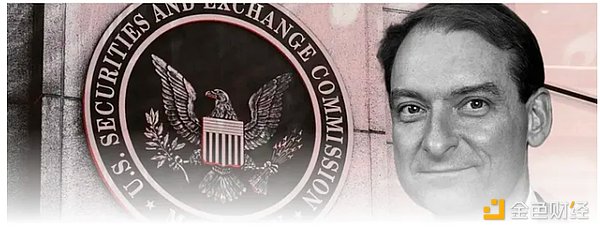
At present, from the SEC's substantial termination of its investigation into Uniswap Labs in early 2025 to the current definition of non-securities in the Crypto Market Structure Act, Uniswap's current token economics scheme means that UNI is no longer at risk of prosecution. With the rise of Trump and his government team, the direction of crypto regulation is to design crypto asset classification methods, Howey tests, and the division of regulatory agency functions in an effort to adapt to the development of the crypto industry, and to discuss with the leading US crypto team. Uniswap Labs also plays an important advisory role in this. After the full relaxation, it may face further regulatory benefits in the future.
1. Project business situation
1. Top business data
Uniswap is the earliest and largest Dex protocol in the crypto market. Its current TVL is 5.12 billion US dollars, and its trading volume in the past 30 days is 84.5 billion US dollars, ranking second after Pancake. Before the launch of Binance Alpha, Uniswap's trading volume ranked first in the market for a long time, generating US$929 million in revenue a year, ranking seventh. If simply calculated according to traditional valuation, the P/E is 4.5-6.4, while Coinbase's P/E is about 33-42, Apple's P/E is about 28-35, and Tesla's P/E is about 50-70. If UNI's "fee switch" can be turned on in the future or the regulation is relaxed to expand its financial application scenarios (currently UNI holders do not participate in profit distribution), the current market value is significantly underestimated relative to its business profitability.
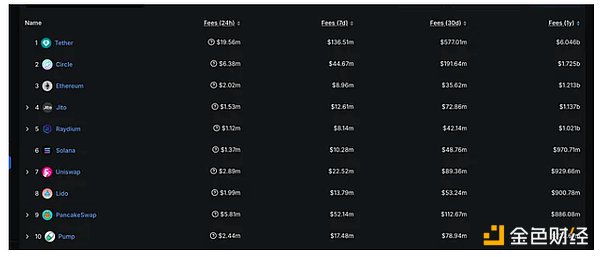
According to the Uniswap Foundation's 2025Q1 financial summary, as of March 31, 2025, the fund held $53.4 million worth of US dollars and stablecoins, 15.8 million UNI (denominated in UNI), and 257 ETH, equivalent to $150 million in tokens at the closing exchange rate on May 28, 2025. The capital turnover period is expected to last until January 2027, and it is currently in good financial condition.

2. Token economic empowerment attempt
In the past token economics of UNI, the main method of using UNI to generate income was to add UNI to a specific paired trading pool as an LP, pledge UNI to participate in the governance of DAO and propose repurchase or liquidity incentives, but these incomes are very indirect and in most cases the yield is low. Directly holding UNI does not directly generate income, which is also the main reason why the price of UNI tokens cannot rise to a very high price. However, Uniswap Labs has been trying to empower the token economy and has proposed a fee switch many times, but it has not been substantially passed and implemented due to regulatory risks. The latest fee switch proposal was restarted in February 2024, and the technical vote was passed in May. On-chain voting is expected to be further promoted in the second half of 2025. Combined with the gradual advancement of the regulatory framework, the fee switch may be activated in the future.
In addition to the fee switch, Uniswap's newly launched Unichain also provides new application scenarios for UNI. Unichain is a Layer 2 (L2) blockchain announced by Uniswap Labs on October 10, 2024. It is based on the Superchain framework of Optimism's OP Stack and the mainnet was officially launched on February 13, 2025. Hayden Adams, CEO of Uniswap Labs, believes that "after years of building and expanding DeFi products, we have seen where blockchain needs to improve and what is needed to continue to advance the Ethereum roadmap. Unichain will provide the speed and cost savings that L2 has achieved, better cross-chain liquidity, and be more decentralized.
Like other L2s, Unichain also has a validator network that uses UNI as a staked token. To become a validator in UVN (Unichain Validator Network), node operators must stake UNI on the Ethereum mainnet. The amount of stake determines the probability of being selected into the active validator set. The income comes from 65% of the net chain income (including basic fees, priority fees and MEV), which is distributed according to the stake weight. At present, the official has not directly disclosed the specific staking scale, but Uniswap Labs continues to support Unichain. If its yield and ecological scale gradually expand, it will introduce more UNI stakes to become a validator and gain income.
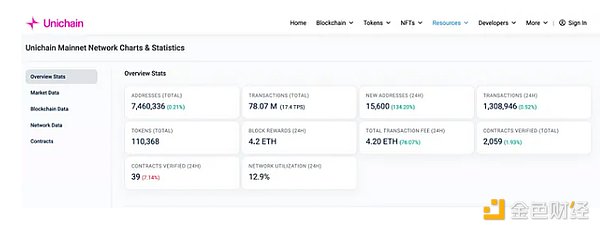
2. Token situation
UNI's current circulation market value is 4.2 billion, FDV is 6.7 billion, the token is fully circulated, and the pledge lock-up is about 37%.

The contract holding volume is 448 million, OI/MC is about 10.6%, the aggregate long-short ratio is 1.02, the Binance account long-short ratio is 2.16, and the large account long-short ratio is 3.87. More long positions come from large accounts. Since the rise of ETH, UNI's OI has also been gradually rising, and the derivatives market has been active.
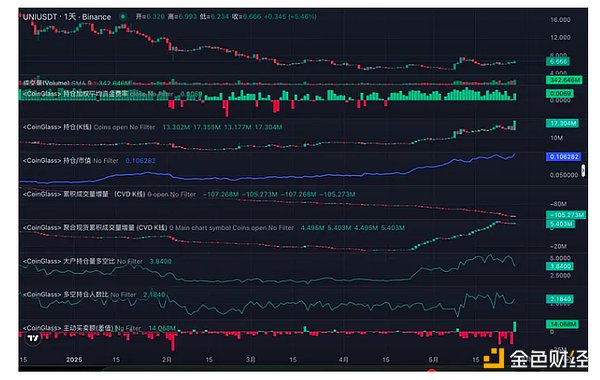
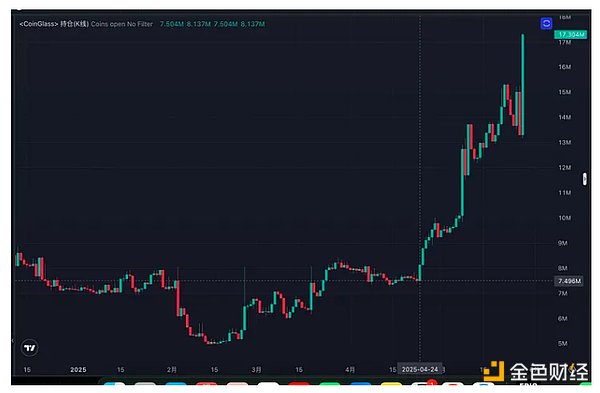
In the spot K-line, in the pattern of ETH's rise in November last year, UNI and ETH showed similar trends in form, but the volatility was about 2-3 times that of ETH. However, in this round of ETH's rise in April, the two trends were similar in form, but ETH's increase was higher than UNI. If the market continues, UNI may have further momentum to make up for the rise.

Fourth, Summary
Since Trump was officially elected as the President of the United States in 2025, how to regulate and integrate the crypto industry has become the most important topic. As the largest Dex protocol in the current crypto market, how the United States regulates it will become a model for the entire industry. Uniswap Labs is also actively participating in the formulation of regulatory rules. Combined with the multiplier effect of ETH, it may usher in structural favorable opportunities. The project's own business data occupies the top of the market, with considerable profits and good finances. Through Unichain's project promotion and the proposal of fee switch, it may bring new empowerment to the token. If you are optimistic about the market outlook, UNI is one of the ETH ecological blue-chip targets worthy of attention.
 Miyuki
Miyuki















